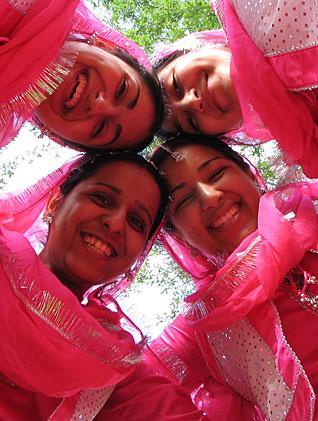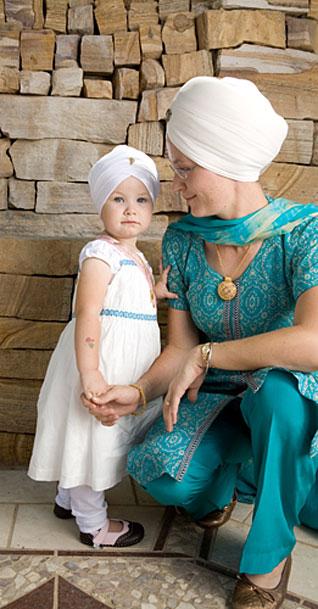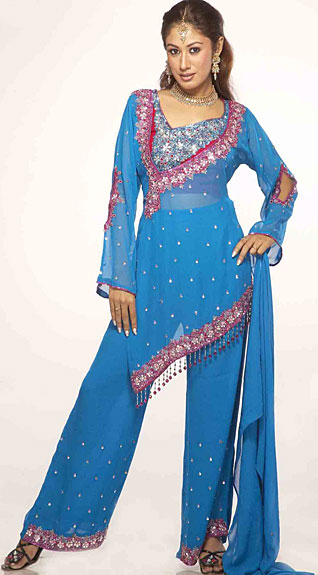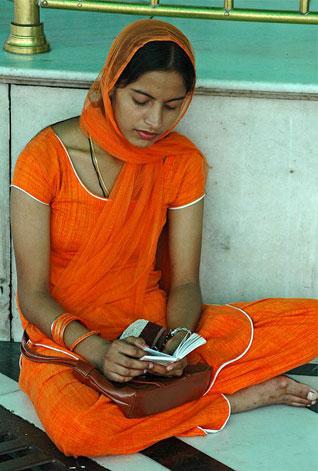
Images below: first from bottom, courtesy - Shunya. Third from bottom, courtesy - Fiona Aboud. Thumbnail, courtesy - Andrew Yoon.



Current Events
Women's Equality:
Why Aren't We Spearheading The Struggle?
by HARINDER SINGH
"The whole Guru Granth is the voice of a wedded woman or a maiden pining in love of the Beautiful. Her nobleness in Guru Granth is infinite, her freedom is of the highest. Both man and woman as sexes are forgotten in her voice. She becomes the supreme reality and a freed soul. In the freed soul alone is the subordination of one to the other effectively abolished and all disputes hushed." - Professor Puran Singh
Doctrinally, for us Sikhs, questions of woman's capacity and capabilities are a moot issue.
The divinity of Guru Nanak was recognized first by the none other than Bebe Nanaki. One of Guru Gobind Singh ji's bravest lieutenants was Mai Bhago.
Thus, the woman's role was neither sanctioned nor codified. It didn‘t need to be. Every woman's (for that matter every Sikh's) personal relationship with the Guru and the Creator moved each Sardarni in the spirit of utter volunteerism to do what she did.
So, why are we a party to a culture of domination today?
I submit: the raison d'etre of a Sikh is to fight every dimension of domination by anyone over another, regardless of whether it is spiritual, political or otherwise. In the past few decades, we've seen a desire to codify women's equality as a global community; however, this ideal is too often couched, albeit earnestly, in terms of a goal sometime in the future.
Paragraph 13 of the United Nation's 1995 Beijing Declaration issued at the fourth World Conference on Women stated: "Women's empowerment and their full participation on the basis of equality in all spheres of society, including participation in the decision-making process and access to power, are fundamental for the achievement of equality, development and peace."
I see our community still "declaring" women to be equal. It is time to stop the symbolic declarations and begin to assert, through our actions, the equal treatment of women in private and public spaces.
Guru Nanak's declaration on women's emancipation came 500 years ago, amidst the clash of Semitic and Aryan traditions, whereas our modern world appears still to be deliberating on it.
For the large part, religions, ideologies and other cultural systems have created strong protections for cohesion of society and nurture of its norms. This end is often ensured by way of controls over behaviour - hence, the preoccupation with gender and sexuality in all systems which guide human interaction.
Characteristically, societies developed a necessary division of labour, loosely based on perceived biological ability. This solidified and eventually extended symbolically, with women responsible for the upbringing of the family and related activities involving cultivating and cooking. Conversely, men related to the wider environment through their engagement in hunting, warfare and political relations.
The subservience of women to men became widespread in all spheres, with rare exceptions. Combined with profound fears about the dangers surrounding sexuality (elaborated in complex ritual customs to deal with "purity" and "security"), these disparities led to the literal separation of women from men, especially in worship.
For me, the height of folly is that Sikhs have fallen victim to the larger hegemony's dictation of how we should think and behave. The results are that we are now debating whether we should allow women to do certain things, be it in our local gurdwara or even within the Darbar Sahib complex.
How absurd!
We have no basis in our doctrine for this prejudice, yet our debate on negative energies continues.
The Sikh culture, as envisioned in the Guru Granth and created by the Ten Nanaks, insists on complete equality. There is no stratification spectrum of inferior or superior status in any form, be it gender or other social divisions. The foundational doctrine of the Sikh Faith propagates integration, not division, to uplift human dignity.
Consequently, the Sikh scriptural canon, the Guru Granth, reveals Waheguru as The One Universal Integrative Force. The succeeding divine attributes are messages of integration; there is no allusion to division based on gender.
In the Sikh vision, the woman is the single thread which drives humanity. Her participation in all dimensions of life must be recognized as the essential elements in human affairs. With the exception of the Divine Order of Waheguru, Guru Nanak in Asa-ki-Var proclaims that everything in human existence depends on the Woman; the only exception being Waheguru, the non-human factor.
We see then that it is not an accident that the perspective adopted for self-realization in gurbani (Sikh scripture) is that of the woman. The feminine vocabulary, symbolism and behaviour are the medium for self-realization, which is the expression of total freedom or Divine realization.
Harinder Singh Mehboob articulates the Woman-consciousness in the Guru Granth as follows:
"In the Guru Granth Sahib, several dimensions of the woman-consciousness are experienced in the spiritual longing of humans. Guru Nanak - Truth did not incorporate it as a mere illustration or thought, rather it is a significant part of the whole experience. Woman is that form of its genius whose intense movement transforms the complete radiant richness of the Creation's fertile aspects into human morality. In the feelings of coming together and pangs of separation, several representative forms of life converge like a great carnival.
"Hence, firstly, the Khalsa must have the complete experience of the woman in accordance with the standards of Divine values; secondly, the Khalsa must be aware of the completeness of the woman in all colours of coming together and pangs of separation: the complete and grave experience intoxicated with pure essence and aesthetical splendour! This experience must have movement, longing, and serene bliss at the same time."
I must ask, are we experiencing this wonder, this vismad?
In the Sikhi lifestyle, Waheguru is enshrined in each and every heart. The same divine light is present in all human beings. Every man and woman is an image of Waheguru. The Gurus were far ahead of their time; they brought clarity by highlighting the prevalent jarring social inequalities. Regarding barring women from participating in society based on their purported association with "impurity," the Guru proclaims, rather, that all doubts in one's mind on this issue are the impurity!
In terms of rights and responsibilities of the Sikhs, here is what the revolution of the Sikh Gurus encompassed:
Admitting women into the sangat (congregation) without any restrictions or reservations; encouraging the education of all Sikhs, men and women included; condemning the cruel custom of sati (the Hindu custom of self- or coerced- immolation of the widow on the husband's funeral pyre); advocating widow remarriage, abolishing purdah (veils); and declaring that "Woman is the Conscience of Man."
Furthermore, the Khalsa initiation ceremony, from day, one was open to men and women alike. Also at the same time, a law was made to not associate with those who practiced female infanticide.
Today though, some in the community, like many other Indians, are still complicit in female feticide! Open your eyes and hearts to the conspiracy of silence surrounding gendercide.
While busy pushing our preferences as laws, we completely disregard the Guru's direct command!
As well, we see that, historically, the Guru forbade Sikhs to exercise any proprietary rights over women captured in battle; they could not be kept as slaves or wives but were to be treated with the utmost respect.
"In all contemporary records, mostly in Persian, written generally by Muslims as well as by Maratha agents posted at a number of places in Northern India, there is not a single instance either in Delhi or elsewhere in which the Sikhs raised a finger against women," records historian Hari Ram Gupta.
The culture can be judged from the position and respect it gives to women.
Today, we are faced with the question, are we part of the Sikh culture or are we more Punjabi, Hindustani, or Firangi? If the answer is we want to be more Sikh-like, the first allegiance needs to be to the Guru Granth - Panth.
I saw an excellent, but disturbing, extrapolation of perversion toward South Asian women in the film Maatr-bhoomi. I look at the alarming statistics on woman-to-man ratios in Punjab. I read testimonies of domestic abuse in Vancouver and London.
Yes, I know versions of this injustice are prevalent in the whole world, in every community. Why, then, should I make noise about it?
Simple. Because even if one woman is treated unfairly, especially by those who claim to be Sikh, it is a crime. Our tradition, in the words of Bhai Gurdas, upholds a very different attitude and we should strive to see it made real: "In world events, literary affairs, virtuous behaviour, and exemplifying wisdom, Woman - half of the population, brings forth freedom."
Roles specified for men or women are antithetical to Sikh beliefs and practices.
Sikh culture incorporates those ideas and practices that do not divide the human race for the purpose of defining their rights and responsibilities. Thus, the classification of roles for women and men becomes an absurdity.
Yes, there are prescribed tasks that are specific to a Sikh. Everything is prescribed for a Sikh by the wisdom of the Guru, from the shakhsi (personal) to the panthak (collective) living. There are enough historical narrations to substantiate this aspect.
Prof. Puran Singh observes: "Never was eastern or western woman so free when she rose like Sundari, the nurse-sister of the Khalsa in times when the Sikhs were pitched against the Mughal empire; Sundari chose her own vocation, dedicated her whole freed life as the sister-nurse alike of the Khalsa and his foes."
That was in the eighteenth century. How are we facilitating the identity formation of Sikh women today? Let us shift our focus away from men's empowerment to the empowerment of all!
The Guru dealt with subordination, prohibitions on remarriage, dowry, menstruation-related taboos, superstitions, and other oppressive customs that had become cemented into society and were propagated by immature or under-developed minds.
Once more, the Guru's dictum, "Burn away those customs that make me forget the Beloved!" must be applied to everything that is designed to keep women subservient, docile and dependent today.
Anything that glorifies male gender preference, encourages female neglect and perpetuates the view of a woman, a wife, a mother, a daughter, as a liability is not aligned with the Sikh vision.
It has been shown that every Sikh has the same rights and responsibilities; there are no separate roles for men or women. Over 500 years ago, Guru Nanak launched a struggle for equal rights. Every single Guru articulated and practiced the equality of men and women while working to liberate women who were captives within their own social hierarchies.
Sikhi rejects gender inequalities; it stresses the familyhood of the human race.
Doctrinally, Sikh women hold an equal status in all affairs, from spiritual to political. It is a shortcoming of the human faculties and a result of the dominance and influence of other cultures that crept into the practitioners of the Sikh faith and began to justify the imposition of an inferior status on the female.
These shortcomings are the product of ignorance on the part of the practitioners as well as the nefarious designs of the forces operating actively to undermine the vision of the Gurus.
We must instead unite in our true understanding of the Sikh revolution and actively create a world that sides with inclusion and love.
I want to challenge all Sikhs, especially those who claim to build panthak institutions, to raise awareness in their communities about women's situation, the discrimination they face everyday, and the work being done to ensure rights and access to opportunities on three fronts:
Firstly, we must invest in women's capacity building and skills development to deal with people and institutions.
Second, we ought to ensure women's participation in every domain of life, offer them greater control, and allow them to assert decision-making power at home, community and society.
Third and finally, we should pledge to work diligently toward transformative action to bring about gender equality between men and women.
Rather than wait for the International Women's Day, let us focus NOW on equality as an objective, not on women as a target group. Men and women need to become partners in its pursuit, rather than throw up their hands and decry that prejudice is too deeply entrenched in our world to be changed, or placate historical wrongs with erratic token advancement. The daunting task is to move beyond mere recognition of gender differences, and increase vital attention to reducing gender disparities!
Harinder Singh is the co-founder and Executive Director of the Sikh Research Institute (SikhRI) which is headquartered in Texas, U.S.A.]
March 27, 2009
Conversation about this article
1: Amardeep (U.S.A.), March 27, 2009, 6:07 PM.
Can we please stop all raagis and preachers in gurdwaras who say, 'may god bless you with puttar di daat' Why not just say, 'Gursikh di daat', and it can be either a boy or a girl. All the famous and important raagis (so called gursikhs) say that.
2: Ibadat Gill (U.S.A.), March 27, 2009, 11:55 PM.
I have noticed that many sehajdhari (patit) families, while doing ardas, omit the line "Sikhan nu kes daan ... bakshna". A sad but true state of affairs. The Sikh religion is being adulterated by people who want to create a new interpretation and meaning to the Guru's teachings - in order to suit their own lifestyles and choices.
3: D.J. Singh (U.S.A.), March 28, 2009, 8:36 AM.
"Pootaa maataa ki aasees" is a shabad by Guru Arjan (GGs, p496). In this shabad, are the blessings addressed to the son or daughter or both? Both SikhiToTheMax and the English translation of Granth Sahib by Dr. Sant Singh Khalsa on sikhs.org translates it as a "son". [Editor: It is the opinion of Sikh scholars with in-depth translating experience that "poota" here is child, and neither son nor daughter. A common and well-accepted term of endearment used by most fathers, in addressing their daughters, is "beta" - which, though literally a "son", is used as "child"!]
4: D.J. Singh (U.S.A.), March 28, 2009, 9:14 AM.
As long as humans feel challenged raising a daughter, there will never be equality of the sexes. And this has nothing to do with any religion.
5: Jodh Singh (Jericho, NY, U.S.A.), March 28, 2009, 3:44 PM.
Harinder Singh has highlighted a stark problem - our challenges related to equality based on sex. He has appropriately quoted Guru Granth Sahib and a number of reputed authors. But may I remind him that we are now educating ourselves and understanding the enigma. The literacy of the Sikhs was less than 10% in 1941 and that was based on the "Three R's" - reading, writing and arithmetic, as promulgated by the British. Our 'clergy' - or whatever we are allowed to have, since priesthood is prohibited in Sikhi - has been semiliterate, with poor training and poor paying jobs. All we had was the Shahid Missionary College and a few seminaries which were going on in the name of the great Sikh scholar and martyr, Baba Deep Singh. The quality of those seminaries caused so much loss and harm to the Sikh Panth that it shall take another century to compensate for it. We do not have evidence-based history. Our only authenticated source is that of Sikhi itself - the Guru Granth - and only because we were uniquely gifted because the Gurus 'received' the bani and wrote it with their own hands. But, instead of reading and understanding and following it, we - for example - perform brahmanical ceremonies of cremating it. Our slipping into old braminical and hindu practices is the major cause of us Sikhs not doing what we are supposed to do.
6: Tejwant (U.S.A.), March 29, 2009, 11:45 AM.
'Women in Sikhi will only have their rightful seat at the table of equality as prescribed by our Gurus in Guru Granth when we follow the Guru Granth through Shabad Vichaar. And Shabad Vichaar can only exist if caretakers of Sikhi at our Takhts are educated so they can set educational standards for the raagis, kathavachaks and all others who are apt to share the Gurmat nectar.' [Source: Sikh Philosophy Network.] Lack of education has created a Taliban mentality of machismo at the top of the gurdwara heirarchy. We can see that inside the Harmandar Sahib where no women raagis are allowed. We do not even see women sevadarnis in there, nor are they allowed to be part of Panj Pyaras. When we start putting emphasis on Gurmat education and allow women to have a seat at the Takhts and we men who live in diaspora start giving a helping hand in household chores and offer women's participation in the Gurdwara committees, then only these small steps can turn into giant leaps. And then, one day, our daughters and their daughters can be the flag bearers of society, no matter where one lives. But first, they should be allowed to carry the Nishaan Sahib of equality within Sikhi. And that can only happen when they are not aborted in any Sikh household. Let us give Sikh women a chance, then only peace can have its.
7: Amardeep (U.S.A.), March 30, 2009, 10:15 PM.
The problem lies in the double standards in raising children - different for boys and different for girls.
8: Harjot Kaur (U.S.A.), December 10, 2009, 3:06 PM.
Raising children is only where the double standards begin. Marriage and sex have found themselves wound all around the "family reputations" of the heads of the family - usually, the father. Women are cast out of their homes after being raped and impregnated, their families not wanting to be seen with an unmarried pregnant daughter, even if the pregnancy wasn't of her choosing. Regarding marriage, finding a "suitable boy" based on the family status is gender inequality, giving no rights nor choice to the bride on her life partner. The ownership of the daughter-in-law by her husband's parents, her changing her home, village or town rather than the groom, or she changing her last name rather than him; dowry ... the list could go on and on. Of course, these customs are very drastically changing here in the U.S. as the generation gap takes its effect between the immigrant parents and their progeny, these unequal practices still occur in Sikh families in Punjab as well as in the diaspora today, and they all overlap one huge concept: culture. Not Sikh culture, but Punjabi culture - the two are two starkly different things. So the problem lies in culture more than anything else. The parents can be blamed, the grandparents oculd be blamed, but truly it is the culture that drives them, and if that changes, then perhaps the women of today will indeed find themselves to be equal to their male counterparts. The trouble with changing culture, however, is that a change on the cultural level doesn't happen on an individual basis: it must come collectively.


